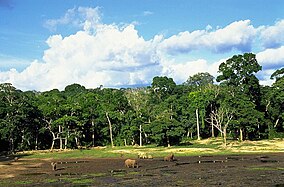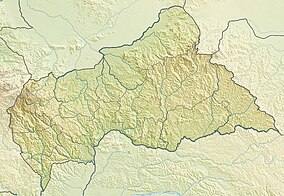Dzanga-Sangha Special Reserve
| Dzanga-Sangha Special Reserve | |
|---|---|
IUCN category VI (protected area with sustainable use of natural resources) | |
 | |
| Location | |
| Coordinates | 3°6′N 16°20′E / 3.100°N 16.333°E |
| Area | 6865.54 km2 |
| Established | 1990 |
| Governing body | Central African Forest Commission |
The Dzanga-Sangha Special Reserve (also known as Dzanga-Sangha Forest Reserve, or Dzanga-Sangha Forest Special Reserve, Dzanga-Sangha Baï, or Dzanga-Sangha Special Forest Reserve) is a protected reserve of southwestern Central African Republic. It was established in 1990 and covers 6,865.54 km2 (2,650.80 sq mi).[1] It is one of several areas within the Dzanga-Sangha Complex of Protected Areas (DSCPA), each within its own protective status and along with Lobéké National Park in Cameroon and Nouabalé-Ndoki National Park in Republic of Congo, it is part of the Sangha Trinational Landscape. Other areas within the DSCPA include the Dzanga Ndoki National Park which has two sectors, the 495 km2 (191 sq mi) Dzanga park and the 725 km2 (280 sq mi) Ndoki park. A conference of the Ministers of Forests of Central African Forest Commission (COMIFAC) had resolved to establish within the Congo Basin, the Sangha River Tri-national Protected area (STN) encompassing these three parks.[2][3] The forest special reserve is operated by the Central African Forest Commission (COMIFAC).[4][5]
History
[edit]The forest special reserve was established in 1990, along with its neighbouring Dzanga Ndoki National Park. Until 1986, anybody was free to shoot game in the forest.[6] The tropical forests of the region have long been threatened by human activities, with international companies and illegal local loggers cutting down trees and mining natural resources.[7] Also, local indigenous peoples are dependent on the forest, clearing land for agriculture, and for basic necessities.
In 1999, the forest special reserve was administered collaboratively by the Central African Ministry of Environment, Water, Forests, Hunting and Fishing, and the World Wildlife Fund.[8] In the same year, the so-called Yaoundé Declaration was signed, forming a tri-national park agreement of cooperation with the Dzanga-Sangha Forest Reserve, Lobéké National Park in Cameroon, and the Nouabalé-Ndoki National Park in the Republic of Congo.[9] This tri-park area is operated by the Central African Forest Commission (COMIFAC), and is overseen and funded by international wildlife groups such as the World Wildlife Fund (WWF), the German Cooperation of Technical Collaboration (GTZ), and the Wildlife Conservation Society (WCS).[4] Along with these other protected areas, it is a candidate for designation as a UNESCO World Heritage Site.[10]
Geography and climate
[edit]
Dzanga-Sangha Forest Reserve lies in the extreme southwest of the Central African Republic, bordering Cameroon to the southwest and Republic of Congo to the southeast. The park consists of nearly 832.5 thousand acres (3,369 km2) of tropical moist forest, much of which is relatively intact.[11] Combined with its sister reserves, Lobéké National Park in Cameroon and the Nouabalé-Ndoki National Park in the Republic of Congo, this rainforest is the second largest on Earth.[4] The main river running through the reserve is the Sangha River, and the tri-park basin area is often referred to as the Sangha River Tri-national Protected Area (STN).[4]
The average annual rainfall is about 1500 mm and the average temperature is 24–29 °C (75–84 °F). The most precipitation in the reserve area falls in the long rainy season from October to November and in the short rainy season between May and June.
Flora and fauna
[edit]
Dzanga-Sangha Forest Reserve is ecologically rich and contains a variety of megafauna such as western lowland gorillas, African forest elephants, bongo antelopes, African forest buffalos,[2] white-nosed and moustache monkeys, grey-cheeked mangabeys, bushpigs, duikers, and many different bird species.[10][11] Of particular note are the western lowland gorillas and forest elephants. Dzanga-Sangha Forest Reserve has one of the highest population densities of gorillas in the world, with an estimated 2000 of them living within the reserve's precincts.[6] Since the establishment of the reserve, it has been an important location for research into the western lowland gorillas [12] and forest elephants, in particular.[13] A number of papers have been published by naturalists working with the park, including the leading expert in the world on forest elephants Andrea Turkalo, and Mike Fay (J. M. Fay) and Marcellin Agnagna.[13] There are thousands of insect species.[7][11] Rodent species include cane rat, giant rat, and porcupine.[8] The reserve is also noted for its dark-crowned forest eagles, which have an average wingspan of 1.55 metres, and the blue-breasted kingfisher.[6]
The tropical forests contain hundreds of plant species, including Entandrophragma angolense, Lophira alata, Manilkara mabokeensis, Monodora myristica, Ricinodendron heudlotii, along with the African tulip tree, rubber tree, strangler fig, and cecropia.[7][9][11]
Mammal species list
[edit]List of larger mammals identified in the reserve (excluding Insectivora, Rodentia and Chiroptera):[14]
Aardvarks
|
|
|
Human population
[edit]
In 1999, Kamiss estimated the human population of the special forest reserve to be 4,500, Within the general population, 2,000–3,000 Baka people live in mud huts or wooden shacks in villages across the reserve. The largest of the villages is Bayanga, while Moussapoula, Kounda-Papaye, and Yobe comprise the smaller ones. Babongo and Lindjombo are difficult to reach. Yandombe, just south of Bayanga, is a fairly new settlement established in 1990. Most agricultural activity, such as subsistence farming, occurs along the main north-south axis road that connects the villages north of Bayanga with Lindjombo to the far south. The main diet of the indigenous people includes cassava, corn, peanuts, robusta coffee, cocoyams, bananas, papayas, wild berries and koko leaf. Fences erected around fields are made of string with various suspended objects such as cans, plastic bags, and milk tin lids.[8][11]
Morrissey noted in 1998 that the unemployment rate was in excess of 90% in this region of the Central African Republic. In November 1996, 20 scholars from the American Museum of Natural History spent time in the village of Bayanga, collecting data on the reserve's ecosystem and traditional ways of life.[11]
Research and tourism
[edit]
In 1997, the WWF has been involved with the Dzanga-Sangha Primate Habituation Program in the park. Since 2001, working with local Baka people and other interests it has facilitated "gorilla tourism" in the park, permitting tourists to approach and spend time with a family of gorillas.[16] Between late 2001 and 2006, over 700 visitors observed the habituated gorilla groups at Bai Hokou.[17]
In 2001, a book was published entitled Inside the Dzanga Sangha Rain Forest: Exploring the Heart of Central Africa, which follows a team of scientists, artists, and filmmakers searching for the lowland gorilla, leopards, and rare birds and insects.[18]
Cornell University researcher Katy Payne began the Elephant Listening Project in a clearing within the dense forest special reserve. A series of digital recorders that are powered by car batteries are picking up very low frequency sounds of elephants, wind and thunder, thus building an "elephant dictionary" to assist elephant researchers.[19]
References
[edit]- ^ "Dzanga-Sangha Special Reserve". World Database on Protected Areas. Archived from the original on 22 August 2016. Retrieved 1 December 2019.
- ^ a b "Central African Republic". Africa's Eden. Archived from the original on 27 March 2010. Retrieved 18 September 2010.
- ^ Balinga, Michael; Moses, Sainge; Fombod, Eunice (August 2006). "A preliminary assessment of the vegetation of the Dzanga Sangha protected area complex, Central African Republic" (PDF). World Wildlife Fund, Smithsonian Institution. pp. 6–7. Retrieved 18 September 2010.
- ^ a b c d "The Sangha River Tri-national Protected Area (STN)". Dzanga-Sangha. Archived from the original on 29 September 2018. Retrieved 18 September 2010.
- ^ "Lowland Gorilla Sangha National Park". The Zambazi Safari and Travel Co. Ltd. Archived from the original on 2010-11-06. Retrieved 2010-09-18.
- ^ a b c Riley, Laura & Riley, William (2005). Nature's strongholds: the world's great wildlife reserves. Princeton University Press. pp. 41–2. ISBN 0-691-12219-9.
- ^ a b c "The Dzanga-Sangha Rainforest". American Museum of Natural History. Archived from the original on 3 April 2009. Retrieved 18 September 2010.
- ^ a b c Kamiss, Amis; Turkalo, Andrea K. (1999-11-30). "Elephant Crop Raiding in the Dzanga-Sangha Reserve, Central African Republic" (PDF). The African Elephant Specialist Group (AfESG). Archived from the original (PDF) on 2012-03-12. Retrieved 2010-09-18.
- ^ a b Curran, Bryan K. "Strategic Planning For Conservation Management Options In The Lobeke Region, Southeastern Cameroon". World Wildlife Fund. Retrieved 18 September 2010.
- ^ a b "Welcome to Dzanga Sangha !". Dzanga-Sangha. Archived from the original on 23 August 2010. Retrieved 18 September 2010.
- ^ a b c d e f Morrissey, Brian, The making of a rainforest (June, 1998), Natural History
- ^ Hanna, Kevin Stuart; Clark, Douglas A.; Slocombe, D. Scott (2007). Transforming parks and protected areas: policy and governance in a changing world. Routledge. p. 107. ISBN 978-0-415-37423-1.
- ^ a b "Research at Dzanga Sangha". Dzanga-Sangha. Archived from the original on 18 October 2010. Retrieved 18 September 2010.
- ^ List of Mammals Archived 2016-03-03 at the Wayback Machine Dzanga-Sangha Special Reserve, Central African Republic
- ^ Cassidy, Rod. "Allens monkey Youtube". YouTube. Sangha Lodge. Archived from the original on 2021-12-15. Retrieved 21 September 2016.
- ^ "Meet the Gorillas of Dzanga-Sangha". World Wildlife Fund Panda. Retrieved 18 September 2010.
- ^ "Western Gorilla Tourism: Lessons Learned from Dzanga-Sangha". Gorilla Journal, Volume 33. December 2006. Archived from the original on 2007-10-21.
- ^ Lyman, Francesca (2001). Inside the Dzanga Sangha Rain Forest: Exploring the Heart of Central Africa. Bt Bound. p. 127. ISBN 0-613-25713-8.
- ^ "Listening to Elephants Novel Way to Study Wildlife Raises Conservation Dilemma". National Public Radio. October 31, 2002. Archived from the original on 17 September 2010. Retrieved 18 September 2010.
External links
[edit]- Official site
- Inventory Of Major Saline Areas Of Dzanga-Sangha, Dzanga-Ndoki Reserve/Park World Wildlife Fund
- Map showing location of the park

